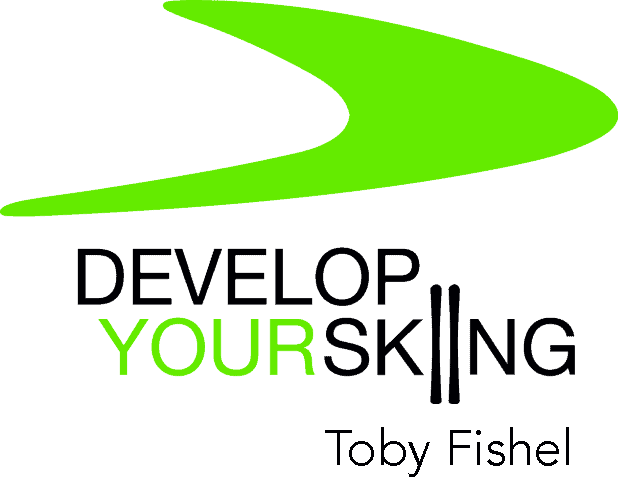The importance of Strategy / decision making
Strategies help your understanding to optimise safety and helps you to make decisions to avoid avalanches and serious accidents.
Using the daily and current avalanche report, weather reports, snow conditions and recent influences on the snowpack can help you make safer decisions for your strategy. Additionally, having knowledge of measures to avoid dangerous and difficult situations, one can avoid extreme conditions and their dangers.
What is the STOP OR GO?
Risk management on ski tours with the help of the stop-or-go card, which explicitly lists all the important steps – from planning to departure.
Stop-or-Go consists of decision strategies (such as limit recommendations in Check 1 and danger signs in Check 2)
STANDARD MEASURES PLANNING – Check I
Avalanche report Danger levels / + steepness, Avalanche problems
Weather report View, Wind, Temperature, Precipitation
Map / Guide / Internet Steepness, Exposure, Current Conditions
Group size, individual skills, willingness to take risks
Emergency equipment Avalanche transceiver, Shovel, Probe, Mobile Phone, First Aid, Bivouac Sack Recommendation: airbag, Helmet
STANDARD MEASURES TERRAIN – Check I / II
Avalanche transceiver check at the starting point
Distance Ascent: 10m from 30⁰, Descent: 30m, from 35⁰ single
Make optimal use of the terrain What is above / below me? Landfall Traps?
Orientation “I know where I am” (visibility!)
Group open communication, pace, breaks, group dynamics
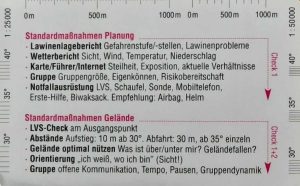
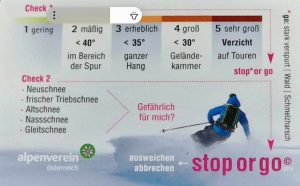
Notes on Check 1
In Check 1, the plan needs to take into account current avalanche danger level which is linked to the slope. The danger level of the avalanche report is therefore a very important input variable in our planning of our days ski tour or freeriding.

Notes on Check 2
Check 2 is a bit more extensive. If our plan has passed Check 1, the next step in the plan is to understand and assess various signs of danger in nature. All these hazard signs are listed in detail on the Stop or Go card under Check 2 – and briefly explained here:

What is the SNOW CARD?
The Snow Card is a tool to get a basic assessment/guideline of the risk when planning tours. With the help of the Snow Card you can estimate the probability of getting into a dangerous situation under certain conditions on the slopes.
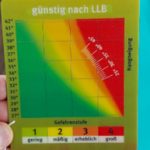
Günstig - favorable daily avalanche report

Ungünstig - unfavourable daily avalanche report
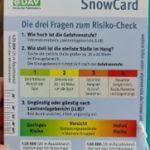
Three questions to ask yourself
THE THREE QUESTIONS TO THE RISK CKECK
How high is the avalanche risk?
The information from the daily avalanche report in area
How steep is the steepest part of slope?
Look for the steepest part approx. 20 x 20 meters in the slope to be skied, the area with be the danger levels of avalanche risk/guidelines.
How favourable or unfavourable is the avalanche level?
If unsure take unfavourable

WHAT IS THE 3X3 FILTER METHOD?
With this 3×3 method, the risk criteria assessed are conditions, terrain and person. We cannot just rely on these 3criterias alone so the assessment tool adds 3 useful filters that help with different perspectives of risk. The 3 filters relate to the broader regional events, local events and zonal events that focus on individual slopes and situations. By combining these 3 criteria with the 3 filters we get a more realistic evaluation of risk and we can form a matrix that will help form the risk assessment during our days freeriding or touring during the day.


